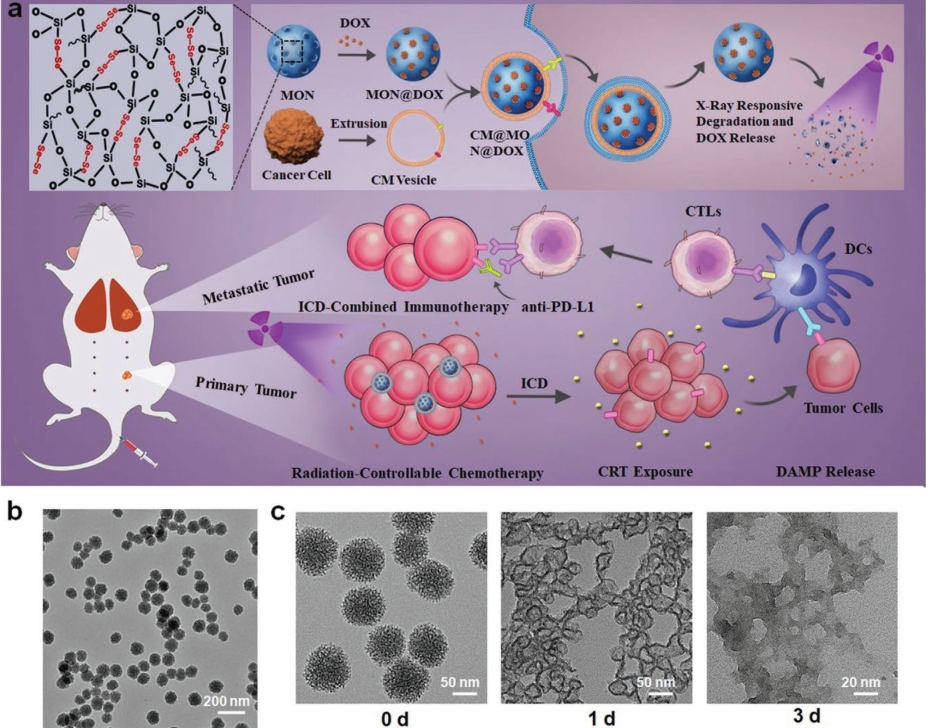Despite recent advances in chemotherapeutics, cancer remains a leading cause of disease-related death worldwide. The clinical outcomes of conventional mono-chemotherapy on cancers remain unsatisfactory. The development of nanomaterials-based drug delivery systems may prove efficient and safe for use in chemotherapy.
In recent years, researchers have been exploring various smart nanocarriers that respond to internal stimuli such as changes in pH, redox potential, and enzymatic activity of tumor microenvironment. Mesoporous organosilica nanoparticles (MONs) are an inorganic-organic hybrid material with large surface area, tunable structure, good biocompatibility and controllable degradation properties which exhibits promising clinical application prospects. To further enhance the control of drug release, there is a critical need to fabricate nanocarriers that can respond to exogenous stimuli such as light, sound, electricity, and magnetism.
Recently, Prof. Wen-fei DONG’s group from the Suzhou Institute of Biomedical Engineering and Technology (SIBET) cooperated with Prof. Dan SHAO from South China University of Technology and Prof. Kam W. Leong from Columbia University. Together they discovered a new feature of the diselenide-bridged mesoporous organosilica material (10.1002/adma. 201801198) which shows that it is an X-ray irradiation degradable material.
In the current work, they optimized the preparation process to obtain diselenide-bridged MONs with moderate particle size, pore size, and selenium content for use loading the conventional chemotherapeutic doxorubicin. Such nanodrugs exhibit sensitive and controllable X-ray responsive degradation ability; the matrix can be rapidly disintegrated the drug explosively released under low-dose X-ray (1 Gy) irradiation.
After cloaking tumor cell-derived cell membranes on the surface of the nanomedicine, the biomimetic nanomedicine achieved tumor-targeted and immune-evasive drug delivery by improving its stability and prolonging blood circulation time. It effectively allowed for low-dose X-ray-mediated chemotherapy and significantly reduced the side effects of doxorubicin in vitro and in vivo.
This treatment strategy can also induce tumor-specific immune response by inducing immunogenic death of tumor cells. The combination of this treatment strategy with the use of immune checkpoint blockers can further promote the systemic anti-tumor immune response, which inhibits the growth of both primary and metastatic tumors.
Based on the excellent X-ray responsive degradation of diselenide-bridged MONs, they can be seen as a potential drug carrier for X-ray-mediated radio-chemotherapy.
Related to this work, a paper entitled “Biomimetic Diselenide-Bridged Mesoporous Organosilica Nanoparticle as an X-Ray-Responsive Biodegradable Carrier for Chemo-Immunotherapy” was published in Advanced Materials and selected for the front cover image.

Figure 1. Un-released Front Cover of Advanced Materials. (Image by Advanced Materials)

Figure 2. The synthesize and X-ray responsive manner of diselenide-bridged silica nanoparticles in chemo-immunotherapy. (Image by SIBET)
Contact
XIAO Xintong
Suzhou Institute of Biomedical Engineering and Technology, Chinese Academy of Sciences (http://www.sibet.cas.cn/)
Phone: 86-512-69588013
E-mail: xiaoxt@sibet.ac.cn